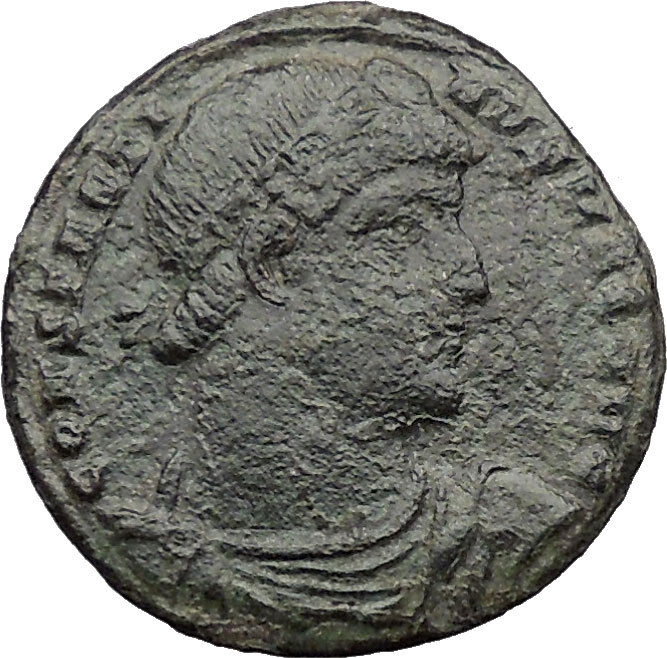|
Arcadius – Roman Emperor: 383-408 A.D. –
Bronze AE4 13mm (1.28 grams) Cyzicus mint 383-392 A.D.
Reference: RIC 26c
(IX, Cyzicus), LRBC 2570
DNARCADIVSPFAVG – Diademed, draped and cuirassed bust
right.
SALVSREIPVBLICAE Exe: Chi-Rho (monogram of Christ) /SMKΔ – Victory advancing
left,
holding trophy and dragging captive.
You are bidding on the exact item pictured,
provided with a Certificate of Authenticity and Lifetime Guarantee of
Authenticity.
The Chi Rho is one of the earliest
christograms
used by Christians. It is formed by superimposing the
first two letters in the Greek spelling of the word
Christ
(
Greek
: “Χριστός” ), chi = ch and rho = r, in such a way to produce
the monogram
☧. The Chi-Rho symbol was also used by pagan Greek scribes to
mark, in the margin, a particularly valuable or relevant passage; the
combined
letters Chi and Rho standing for chrēston, meaning “good.”
Although not technically a cross, the Chi Rho invokes the crucifixion
of Jesus as well as symbolizing his status as the Christ. There is early
evidence of the Chi Rho symbol on Christian Rings of the third century.
In
Greek mythology
,
Nike was a
goddess
who personified
victory
, also known as the Winged Goddess of
Victory. The Roman equivalent was
Victoria
. Depending upon the time of various
myths, she was described as the daughter of
Pallas
(Titan) and
Styx (Water) and the sister of
Kratos
(Strength),
Bia
(Force), and
Zelus
(Zeal). Nike and her siblings were close
companions of Zeus
, the dominant deity of the
Greek pantheon
. According to classical (later)
myth, Styx brought them to Zeus when

the
god was assembling allies for the
Titan War
against the older deities. Nike
assumed the role of the divine
charioteer
, a role in which she often is
portrayed in Classical Greek art. Nike flew around battlefields rewarding the
victors with glory and fame.
Nike is seen with wings in most statues and paintings. Most other winged
deities in the Greek pantheon had shed their wings by Classical times. Nike is
the goddess of strength, speed, and victory. Nike was a very close acquaintance
of Athena
, and is thought to have stood in
Athena’s outstretched hand in the statue of Athena located in the Parthenon.
Nike is one of the most commonly portrayed figures on Greek coins.
Names stemming from Nike include amongst others:
Nicholas
, Nicola, Nick, Nikolai, Nils, Klaas,
Nicole, Ike, Niki, Nikita, Nika, Niketas, and Nico.
In
Roman mythology
, Victoria was the personification/Goddess of victory.
She is the Roman version of the
Greek goddess
Nike
, and was associated with
Bellona
. She was adapted from the
Sabine
agricultural goddess
Vacuna
and had
a
temple
on the
Palatine Hill
. Her name (in Latin) means victory. Unlike the Greek Nike, Victoria (Latin
for “victory”) was a major part of Roman society. Multiple temples were erected
in her honour. When her statue was removed in 382 AD by emperor
Gratianus
there was much anger in Rome. She was normally worshipped by
triumphant
generals returning from war. Also unlike the Greek Nike, who was known for success in athletic games such
as chariot races, Victoria was a symbol of victory over death and determined who
would be successful during war. Appearing on Roman coins, jewelry, architecture, and other arts, Victoria is
often seen with or in a
chariot
. An
example of this is her place upon the
Brandenburg Gate
in Berlin, Germany.
Flavius
Arcadius (377/378–1 May 408) was
Byzantine Emperor
in the Eastern half of the
Roman
Empire
from 395 until his death.
//
Arcadius was born in
Hispania
,
the elder son of
Theodosius I
and
Aelia Flaccilla
, and brother of
Honorius
, who would become a
Western Roman Emperor
. His father declared him an
Augustus
and co-ruler for the
Eastern half of the Empire
in January, 383. His younger brother was also
declared Augustus in 393, for the Western half.
As emperors, Honorius was under the control of the Romanized
Vandal
magister militum
Flavius
Stilicho
while Arcadius was dominated by one of his ministers,
Rufinus
. Stilicho is alleged by some to have wanted control of both
emperors, and is supposed to have had Rufinus assassinated by Gothic mercenaries
in 395; though definite proof of Stilicho’s involvement in the assassination is
lacking, the intense competition and political jealousies engendered by the two
figures compose the main thread of the first part of Arcadius’ reign. Arcadius’
new advisor, the eunuch
Eutropius
, simply took Rufinus’ place as the power behind the Eastern
imperial throne.
Arcadius was also dominated by his wife
Aelia
Eudoxia
, who convinced her husband to dismiss Eutropius, who was holding the
consulate, at the height of his power, in 399. That same year, on the 13th July,
Arcadius issued an edict ordering that
all remaining non-Christian temples should be immediately demolished
.
Eudoxia’s influence was strongly opposed by
John Chrysostom
, the
Patriarch of Constantinople
, who felt that she had used her family’s wealth
to gain control over the emperor. Eudoxia used her influence to have Chrysostom
deposed in 404, but she died later that year. Eudoxia gave to Arcadius four
children: three daughters,
Pulcheria
,
Arcadia and Marina, and one son, Theodosius, the future Emperor
Theodosius II
.
Arcadius was dominated for the rest of his rule by
Anthemius
, the
Praetorian Prefect
, who made peace with Stilicho in the West. Arcadius
himself was more concerned with appearing to be a pious
Christian
than he was with political or military matters, and he died, only
nominally in control of his empire, in 408.
>
Character and works
In this reign of a weak emperor dominated by court politics,
a major theme was the ambivalence felt by prominent individuals and the court
parties that formed and regrouped round them towards
barbarians
,
which in Constantinople at this period meant
Goths
. In the
well-documented episode that revolved around
Gainas
, a
number of Gothic foederati stationed in the capital were massacred, the
survivors fleeing under the command of Gainas to
Thrace
, where
they were tracked down by imperial troops and slaughtered and Gainas dispatched.
The episode has been traditionally interpreted as a paroxysm of anti-barbarian
reaction that served to stabilise the East. The main source for the affair is a
mythology à clef by
Synesius
of
Cyrene, Aegyptus sive de providentia, (400)
an Egyptianising allegory that embodies a covert account of the events, the
exact interpretation of which continues to baffle scholars. Synesius’ De
regno, which claims to be addressed to Arcadius himself, contains a tirade
against Goths.
A new
forum
was built in the name of Arcadius, on the seventh hill of
Constantinople, the Xērolophos, in which a
column
was begun to commemorate his ‘victory’ over Gainas (although the
column was only completed after Arcadius’ death by
Theodosius II
).
The
Pentelic marble
portrait head of Arcadius (illustration) was
discovered in Istanbul close to the Forum Tauri, in June 1949, in excavating
foundations for new buildings of the University at
Beyazit
.
The neck was designed to be inserted in a torso, but no statue, base or
inscription was found. The
diadem
is a
fillet with rows of pearls along its edges and a rectangular stone set about
with pearls over the young emperor’s forehead.
|











